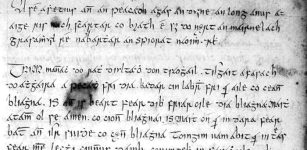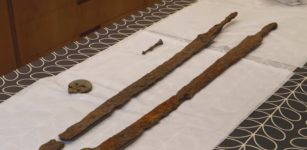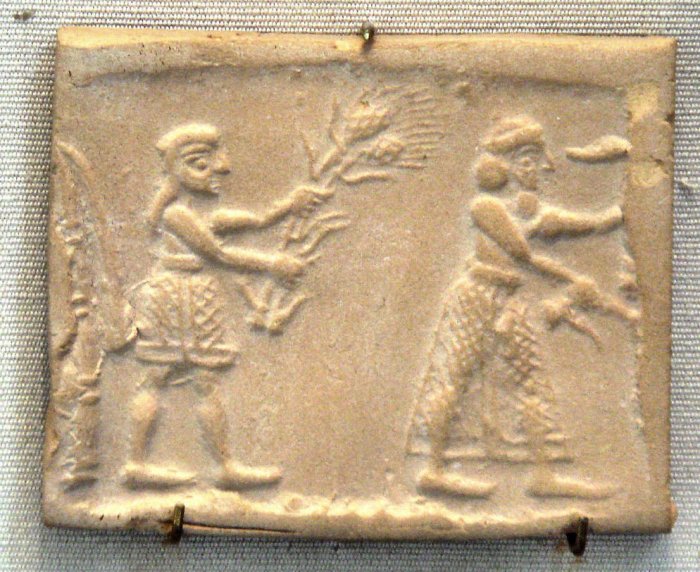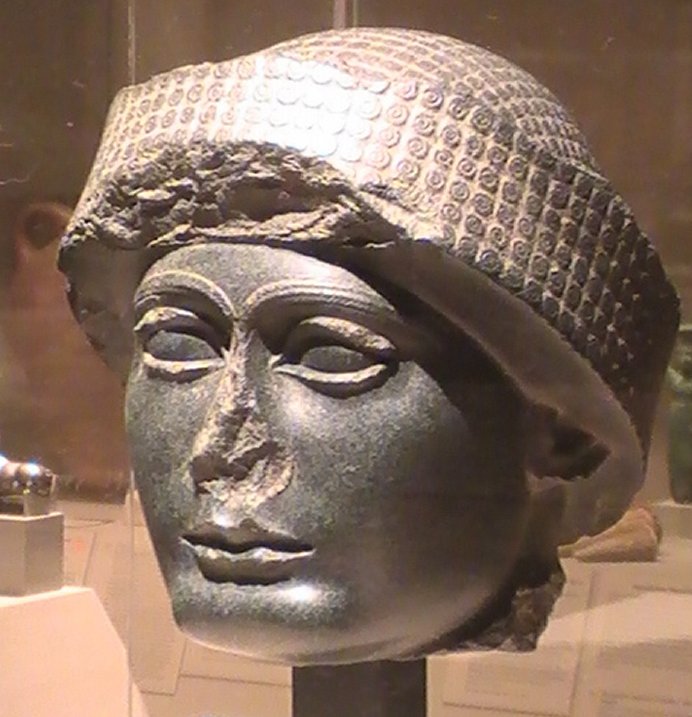Who Was The Sumerian Ensi?
A. Sutherland - AncientPages.com - Assyriologists have identified around twenty central provinces, and much we know today about Sumer originates from archives related to the sites of Girsu (Tello), Umma, Ur, Nippur, and Puzriš-Dagan (Drehem, a suburb of Nippur).
Sumerian cylinder seal impression dating to c. 3200 BC, showing an ensi and his acolyte feeding a sacred herd. Image credit: PHGCOM - CC BY-SA 4.0
Especially the collections from Umma and Girsu-Lagash are practically the only surviving provincial archives from the times of the Third Dynasty from Ur, which can serve as the basis for the study of local power structures, including the position of ensi.
A two-headed power controlled these provinces: one of them was a civil governor, ensi, who directed the administration and the sector of the temples and represented the highest judicial authority of the province.
The other was a post of the military governor (sagina) of Ur, a position which may have been a promising starting point for a career. The sagina reported directly to the authority of the king or the grand vizier. It was, therefore, independent of ensi.
However, the functioning of the empire's peripheries is less well known.
Ensi Managed The Community In Time Of Peace And War
The titles of king-priest en and king-commander of Lugal were adopted by the rulers of the main Sumerian cities, which ruled over larger, loosely integrated organizational territories.
In the Old Sumerian Period, divided into the Pre-dynastic Period (3000 BC to 2800 BC) and Early Dynastic Period (2800 BC to 2340 BC), the term ensi was one of the titles of independent Sumerian city-rulers. They held most political power in Sumerian city-states during the Uruk period (c.4100-2900 BC).
The ensi title meant "head of agricultural work" and originally referred to the coupling manager belonging to the commune. However, since the donkeys that were harnessed to the plow also pulled carts going to war, ensi could, therefore, also manage the community during the war or some important public tasks.
Head of Gudea in polished diorite, reign of Gudea (Boston Museum of Fine Arts). Image credit: Kkhemet - CC BY-SA 4.0
The title describing the city's independent ruler was widespread only in the 3rd millennium BC. At the end of this millennium, during the reign of the 3rd dynasty of Ur, ensi was exclusively the province administrator, who was on behalf of King Ur.
In the later Sumerian period, an ensí was subordinate to a lugal. Nevertheless, even the powerful rulers of the Second Dynasty of Lagash (c. 2100 BCE), such as Gudea were satisfied with the title 'ensí.'
Gudea - the King-Priest of the Sumerian city of Lagash, located in southeast Mesopotamia - was one of them. He possessed significant influence in Sumer during his 20-year-long reign. He chose the title of ensi (town-king or governor), instead of the title 'lugal.'
From the Old Akkadian period (the time of Sargon the Great), the term 'ensi' meant only a province governor subordinate to the king. In later eras, it retained the same meaning, including the Babylonian state.
In the city-state of Ashur, the hereditary ruler bore the Akkadian language version of the title ensí, while the patron deity was regarded as (šarrum - the Akkadian for "king."
Ensi – A Dignity Of Sumerian Temple
The highest dignity of the Sumerian temple city was the 'Ensi.' Originally, ensi probably meant a high priest whose powers included supervision over the construction of the temple.
He was also a worldly ruler, chief priest, chief military officer, and prominent, the earthly representation of the city god. He had full legislative, military, administrative, and judicial power on his territory.
If the local prince was able to bring under domination other city-states as well, he became 'lugal' (or 'great man/ruler') because his supremacy began to encompass a more extensive territory; he was called 'lugal,' translated as "great man." He ruled on behalf of the local god and headed the priests forming the ruling elite. If a "center of power" comprised several cities, the leading city prince (or "ensi") was responsible for the title "Lugal."
Ensi was considered chosen by the gods and possessed absolute power; however, it was more of an "absolutist system" than a system based on religious values. When the city prince lost the favor of the various gods - symbolized by catastrophes including incursions by enemies, illnesses, and natural events), he was quickly replaced by another "chosen one," who was probably recruited from the "Assembly of Elders."
A woman could not obtain this title but still hold a high position within the temple. In this respect, the Sumerians were somewhat progressive people. Each Sumerian city had a temple dedicated to its guardian deity and would either be governed by an ensi or a lugal.
Written by – A. Sutherland - AncientPages.com Senior Staff Writer
Updated on March 4, 2023
Copyright © AncientPages.com All rights reserved. This material may not be published, broadcast, rewritten or redistributed in whole or part without the express written permission of AncientPages.com
Expand for referencesReferences:
Samuel Noah Kramer, History Begins at Sumer
Gary A.Thomson, First Writers - The Sumerians: They Wrote on Clay
More From Ancient Pages
-
 1,800-Year-Old Villa Of Famous Ancient Fisherman Phainos Unearthed In Turkey
Archaeology | Jun 20, 2018
1,800-Year-Old Villa Of Famous Ancient Fisherman Phainos Unearthed In Turkey
Archaeology | Jun 20, 2018 -
 Why Is A Biscuit Named After Giuseppe Garibaldi – Italy’s Military Leader And Hero?
Ancient History Facts | Feb 19, 2017
Why Is A Biscuit Named After Giuseppe Garibaldi – Italy’s Military Leader And Hero?
Ancient History Facts | Feb 19, 2017 -
 Linked Human Skeletons Lying In Spiral Circle Unearthed In Pre-Aztec Burial Pit Near Mexico City
Archaeology | Feb 7, 2018
Linked Human Skeletons Lying In Spiral Circle Unearthed In Pre-Aztec Burial Pit Near Mexico City
Archaeology | Feb 7, 2018 -
 Sea Sequin ‘Bling’ Links Indonesian Islands’ Ancient Communities
Archaeology | Aug 16, 2023
Sea Sequin ‘Bling’ Links Indonesian Islands’ Ancient Communities
Archaeology | Aug 16, 2023 -
 The Maya Produced Rubber 3,000 Years Before Goodyear
Ancient History Facts | Mar 12, 2016
The Maya Produced Rubber 3,000 Years Before Goodyear
Ancient History Facts | Mar 12, 2016 -
 Is This The World’s Oldest Joke?
Featured Stories | Feb 21, 2014
Is This The World’s Oldest Joke?
Featured Stories | Feb 21, 2014 -
 Ancient Irish Practiced Special Burial Rituals Such As Dismemberment Of Bodies
Archaeology | Sep 18, 2017
Ancient Irish Practiced Special Burial Rituals Such As Dismemberment Of Bodies
Archaeology | Sep 18, 2017 -
 Ancient Artifacts Hidden Beneath The Ice In Danger As Glaciers Are Melting
Archaeology | Oct 19, 2020
Ancient Artifacts Hidden Beneath The Ice In Danger As Glaciers Are Melting
Archaeology | Oct 19, 2020 -
 Baba Yaga: Enigmatic, Powerful Archetypal Witch In Slavic Folklore
Slavic Mythology | May 16, 2016
Baba Yaga: Enigmatic, Powerful Archetypal Witch In Slavic Folklore
Slavic Mythology | May 16, 2016 -
 On This Day In History: Sir Francis Drake Sets Sail On His Round-The-World Voyage – On Dec 13, 1577
News | Dec 13, 2016
On This Day In History: Sir Francis Drake Sets Sail On His Round-The-World Voyage – On Dec 13, 1577
News | Dec 13, 2016 -
 Unique Ancient Roman Cavalry Swords Found In Cotswolds, UK
Archaeology | Sep 18, 2023
Unique Ancient Roman Cavalry Swords Found In Cotswolds, UK
Archaeology | Sep 18, 2023 -
 Massive trophy skull rack discovered in the Aztec ruins
Artifacts | Aug 22, 2015
Massive trophy skull rack discovered in the Aztec ruins
Artifacts | Aug 22, 2015 -
 DNA Reveals 300,000 Years Of Hominin And Animal Presence At Denisova Cave
Archaeology | Jun 26, 2021
DNA Reveals 300,000 Years Of Hominin And Animal Presence At Denisova Cave
Archaeology | Jun 26, 2021 -
 DNA Analysis Shows Griffin Warrior Ruled His Greek Homeland
Archaeology | Aug 26, 2022
DNA Analysis Shows Griffin Warrior Ruled His Greek Homeland
Archaeology | Aug 26, 2022 -
 Earliest Modern Human Fossil Outside Africa Unearthed At Misliya Cave, Israel
Archaeology | Jan 27, 2018
Earliest Modern Human Fossil Outside Africa Unearthed At Misliya Cave, Israel
Archaeology | Jan 27, 2018 -
 Mysterious Ancient Jade Artifact May Offer Evidence Of Trans-Pacific Contact – Did Ancient Sailors From California Visit New Guinea?
Artifacts | Jan 14, 2018
Mysterious Ancient Jade Artifact May Offer Evidence Of Trans-Pacific Contact – Did Ancient Sailors From California Visit New Guinea?
Artifacts | Jan 14, 2018 -
 Long-Lost Artifact Re-Discovered In Michigan Offers Evidence Of Overseas Visitors In Pre-Columbian Times
Legends And Mysteries Of North America | Jul 16, 2024
Long-Lost Artifact Re-Discovered In Michigan Offers Evidence Of Overseas Visitors In Pre-Columbian Times
Legends And Mysteries Of North America | Jul 16, 2024 -
 Suomenlinna Fortress: Impressive ‘Castle Of Finland’ Has Rich History
Featured Stories | Feb 13, 2016
Suomenlinna Fortress: Impressive ‘Castle Of Finland’ Has Rich History
Featured Stories | Feb 13, 2016 -
 Famed Makishi Dancers And Likumbi Lya Mize Ceremony In Zambia – Much More Than Just A Festival
Ancient Traditions And Customs | Aug 6, 2019
Famed Makishi Dancers And Likumbi Lya Mize Ceremony In Zambia – Much More Than Just A Festival
Ancient Traditions And Customs | Aug 6, 2019 -
 Rök Stone (Rök Runestone): Longest Runic Inscription Ever Discovered
Featured Stories | Jun 12, 2024
Rök Stone (Rök Runestone): Longest Runic Inscription Ever Discovered
Featured Stories | Jun 12, 2024


